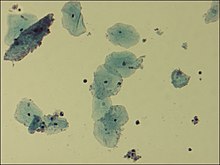| Gardnerella | |
|---|---|

| |
| Microscopic picture of vaginal epithelial clue cells coated with Gardnerella vaginalis, magnified 400 times | |
| Scientific classification | |
| Domain: | Bacteria |
| Phylum: | Actinomycetota |
| Class: | Actinomycetia |
| Order: | Bifidobacteriales |
| Family: | Bifidobacteriaceae |
| Genus: | Gardnerella Greenwood and Pickett 1980[1] |
| Species[2] | |
| |
Gardnerella is a genus of Gram-variable-staining facultative anaerobic bacteria.[1]
Eponym
[edit]It is named after Hermann L. Gardner (1912–1982), an American bacteriologist who discovered it in 1955.
References
[edit]- ^ a b J. R. Greenwood; M. J. Pickett (January 1980). "Transfer of Haemophilus vaginalis Gardner and Dukes to a New Genus, Gardnerella: G. vaginalis (Gardner and Dukes) comb. nov". International Journal of Systematic Bacteriology. 30 (1): 170–178. doi:10.1099/00207713-30-1-170.
- ^ Euzéby JP, Parte AC. "Gardnerella". List of Prokaryotic names with Standing in Nomenclature (LPSN). Retrieved May 12, 2022.
Well, that’s interesting to know that Psilotum nudum are known as whisk ferns. Psilotum nudum is the commoner species of the two. While the P. flaccidum is a rare species and is found in the tropical islands. Both the species are usually epiphytic in habit and grow upon tree ferns. These species may also be terrestrial and grow in humus or in the crevices of the rocks.
View the detailed Guide of Psilotum nudum: Detailed Study Of Psilotum Nudum (Whisk Fern), Classification, Anatomy, Reproduction